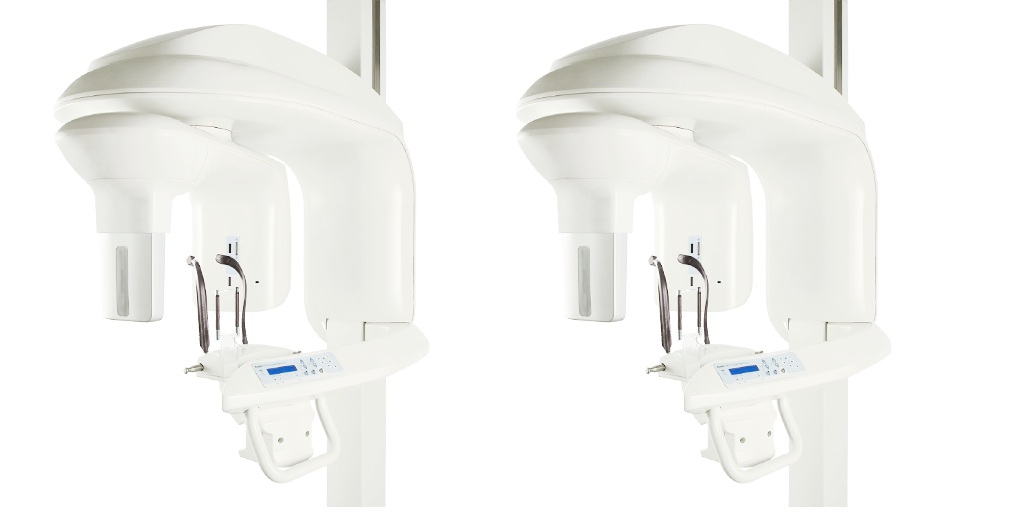Dental cone beam computed tomography (CBCT) is a special type of X-ray equipment used to produce three-dimensional images of facial bone anatomy, including the teeth, soft tissues, nerve pathways, and bone, all in a single scan. The 3D images are particularly useful to doctors to evaluate the jaw, dentition, and bony structures of the face, nasal cavity, and sinuses.
In many cases, dental professionals and specialists are able to use CBCT imaging to be able to offer optimized imaging for specialized treatments, such as dental implants, to their patients. If the doctor is able to make an investment in an in-house dental cone beam system, they are able to minimize outsourcing to have 3D imaging available to patients at any time – increasing efficiencies and reducing the amount of times required to see a patient.
It’s also important to keep in mind that most dental cone beam systems also have a dedicated 2D panoramic imaging setting for capturing traditional 2D scans as well. In this instance, upgrading will not limit the capabilities of a practice; it will only expand them. This flexibility also enables dental professionals to adhere to the ALARA (As Low As Reasonably Achievable) principle while administering dental X-rays to patients.
With many dental cone beam systems available in the marketplace today, it’s important to understand the types of CBCT so you can match your imaging needs to a specific type of equipment.
Understanding Field of View (FOV)
Regardless of manufacturer, dental cone beam systems are typically categorized by three FOV groups: small, medium, and large. The FOV size is largely determined by the applications or procedures for which it will be used. Most medium and large FOV cone beam systems can often collimate down to achieve smaller FOV sizes, so they can differ greatly by model. FOV sizes are typically measured in centimeters (cm).
Most equipment dealers and other sellers will help narrow your search for a CBCT system by dividing their inventory into these three FOV categories. Here’s a general breakdown of what each FOV size is used for in dental practices.
Small FOV
Small FOV dental cone beam systems typically capture a 5x5cm field of view or similar. Often, these smaller scans are equipped with a high-definition mode to capture fine details, as needed for endodontics and some implant procedures. A small FOV dental cone beam system is the right choice for you if you only need to view one or two teeth at a time and is best suited for endodontics and single implant treatments.
Medium FOV
A medium FOV dental cone beam system typically captures an 8x8cm scan or similar. Medium FOV cone beam dental machines are ideal for single or dual arch applications, as well as guided implant surgery. Medium FOV CBCT systems, often the best choice for most general dentists, are ideal for surgical guides, viewing impacted teeth, and other applications requiring one or more full dental arches. Most medium FOV systems will allow you to also capture small FOV scans to minimize the patient dose.
Large FOV
The largest FOV systems start around 13 to 15cm and can go as large as 17 to 23cm. Large FOV cone beam systems are necessary for evaluating trauma cases, TMJ disorders, airway and sleep apnea studies, ectopic and impacted teeth and third molars, orthognathic surgery, and assessing skeletal symmetry. Most large FOV systems also collimate down to capture smaller FOVs to help you adhere to the ALARA principle when prescribing CBCT radiographs. Doctors in oral surgery, orthodontics, and sleep medicine will find this size to be the most helpful.
Other Categorizations for Dental Cone Beam Systems
Outside of FOV size, there are a few other considerations that will help you find the right type of CBCT system. While most brands offer CBCT systems with a dedicated panoramic for 2D imaging, some brands also offer CBCT with an optional ceph attachment. This means the ceph is either included or upgradeable in the future. A ceph is primarily used for orthodontic work, for viewing a front-to-back section of the skull – an angle that helps with teeth alignment.
Additionally, you may be looking for features to help customize to your imaging needs and patient care. Some brands, like i-CAT, offer a 3-in-1 system to get a pan/ceph and CBCT image in a single scan.
While most manufacturers will differentiate their types of dental cone beam models by FOV size, these considerations are also important to keep in mind as you shop.
Where to Begin?
Making the investment in advanced technology requires careful consideration and planning. You want to be sure you’re getting the best value and making the right decision for your practice. For over 10 years, Renew Digital has helped their customers save money on their CBCT purchases by purchasing certified pre-owned systems.
And with their brand-neutral approach, their knowledgeable and experienced sales reps can recommend the right product for your practice based on your unique imaging needs. Start your CBCT machine purchase plan with a call to their sales reps at 888-246-5611 or fill out an online contact form.



